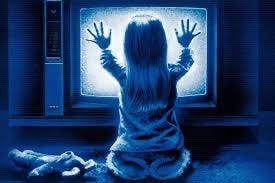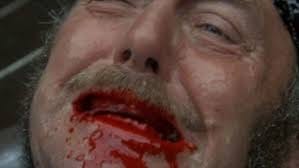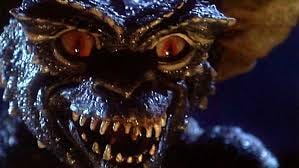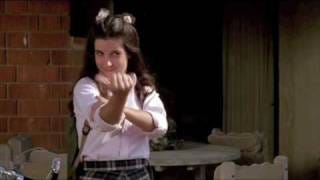(Note: This is Episode Five of a series of deep dive essays into some of Hollywood’s greatest and most-enduring movies… as defined by, well, by me)
EPISODE THREE: WORKING GIRL
EPISODE FOUR: THE SILENCE OF THE LAMBS
EPISODE FIVE: POLTERGEIST
In the long proud history of the Hollywood horror movie, the Haunted House is not only the oldest of the classic horror movie structures, but also the most reliable. From “Dracula” and “Frankenstein” to “The Haunting of Hill House” to “The Amityville Horror”, “House”, “The Shining”, “The Conjuring”, “The Exorcist”, “The People Under the Stairs”, “Hereditary” and “Barbarian”, the genre has been endlessly updated over the years as the times, and the culture have changed.
But “Poltergeist” remains unique in the annals of Hollywood horror history, a true original even on this well-trod-upon ground. It is the rare Haunted House movie that is both absolutely terrifying, but also full of wonder, emotion and heart… Shirley Jackson and Edgar Allan Poe by way of Amblin.
Because we’ve all seen and love the movie, it seems perfectly reasonable here in 2025 that Hollywood could once have made a “four-quadrant” PG horror movie that was actually terrifying. But even in 1982 it wasn’t easy and it took no less a genius than Steven Spielberg to come up with a feasible way to actually do it.
To release a horror movie with a PG rating in this current environment is to consign that movie to a quick anonymous death on a streaming platform. But you could get away with a lot more in the 80’s than you can now… what constituted a “PG” movie that was appropriate for kids in the 80’s (Raiders of the Lost Ark, Star Wars, Back to the Future, The Lost Boys, Goonies, Young Sherlock Holmes, The Secret of NIMH, Gremlins) was a very different thing than what it means now, and the existence of “Poltergeist”, like so many of the truly great American movies made before 2000, feels like something we lucked into once upon a time in a very different America, one that existed before everyone “came to their senses.”
Throughout his career, Spielberg was a master at breaking the one rule that is nearly inviolate here in the movie world of 2025, and that is, “never put a child in real jeopardy in a PG movie.” Spielberg repeatedly bucked this rule (the toddler abducted by aliens in “Close Encounters” is a particular favorite of mine) and never apologized for it because he understood that kids need jeopardy in their movies… real jeopardy. He also understood how to create movies where the jeopardy was just scary enough to create real stakes for the kids sitting next to their parents in the theater, while stopping just short of giving those parents second thoughts about their child-rearing choices.
It has become a cliche to say that times have changed, and that they have done so mostly for the worse, but here I think we have a vastly under appreciated example of that truism… if I, as an older Dad, suggested to the parents of my 10-year-old son’s friends, who are mostly from a younger generation for whom safety-first helicopter parenting is highly prized, that I wanted to take their kids to see “Gremlins”, “Jaws” or even “Temple of Doom” in a theater, I suspect that the next call I would get might be from Social Services.
There is a reason why great movies are sometimes described as a “roller coaster ride.” Roller coasters are fun, but the best of them are also scary. When you get off the ride you feel both exhausted and exhilarated by the stew of adrenaline dumped into your veins. When I was a kid, I would often emerge into the sunlight after having watched one of the great movies of the 80’s feeling that same way… like I’d just survived some life-or-death struggle right alongside my silver screen heroes.
“Poltergeist” is exactly that kind of movie.
Now, imagine that you’re Steven Spielberg and you’ve decided to produce a PG-rated family horror movie, Tobe Hooper is perhaps the last person on earth whom you would hire to direct it. I remember being a kid and watching “The Texas Chainsaw Massacre” for the first time at a sleepover with friends well after midnight on an old VHS tape. We rewound it to re-watch the “hammer kill” over-and-over and argued whether or not what we’d just seen was an actual snuff film. Absolutely brutal horror filmmaking. Nevertheless, Hooper turned out to be the exact right guy to direct this new version of the Haunted House movie… one that took place amidst the drudgery of a cookie-cutter American subdivision.
Rumors that the production of “Poltergeist” was an ugly creative tug-of-war between Hooper and Spielberg have persisted in the decades since the movie’s release, but all the available evidence suggests that while Spielberg had an outsized role in the production relative to most producer/writers, he and Hooper worked well together, the set was a highly-functioning one, and that if there were any hard feelings, they did not persist beyond the release date.
But to the extent that creative conflict did occur on the set of “Poltergeist”, it seems to have been of the productive kind. The marriage between Hooper’s instinct for brutal original scares and Spielberg’s almost supernatural ability to fill our hearts and minds with wonder in any genre he tackled, produced something truly special.
One of the things I’ve always tried to keep in mind when developing a movie idea is that movies and the marketing machines which sell them mirror human romantic relationships. What I mean by that is while a movie trailer may be the thing to which we are initially “attracted”, the best movies spend significant time introducing us to the characters and allowing the story breathe before the plot begins to happen. In other words, we have to date the characters for a while before we can fall in love with them.
Or at least that’s the way it used to be. Modern movies often function less like long-term relationships and more like “hook up culture” where much of the action happens right up front. The “cold open” in which something exciting or scary happens in a movie immediately, even before we’ve been introduced to the world or the characters, is more analogous to the drunken one night stand where dessert is delivered before the vegetables.
But as with “The Exorcist”, “Die Hard”, “Superman”, “American Flyers” and other movies I’ve written about here at The Congress, “Poltergeist” is full of scenes that don’t drive the plot at all, but which are funny or endearing and which deliver important character or story information in ways that don’t feel like rote exposition. Scenes like Stephen Freeling’s remote control battle with his neighbor, or the scene where the family buries Carol Ann’s parakeet, or the scene where the Freeling’s precocious teenaged daughter takes time out of her day to deliver an elaborately crafted bird to the knuckleheads (including a young Sonny Landham) building the family pool…
And then there’s this scene where Stephen and Diane get high while horsing around in their bed after the kids have gone to sleep, which is completely unnecessary to the plot, but which is utterly charming and does more in two minutes to endear us to these characters than many movies do in two hours.
Without this scene, in which we see how much these two busy parents still love each other and enjoy spending time together, the best scene in the movie, one in which Stephen must let Diane walk into the inter-dimensional closet at the other end of a rope in order to bring their daughter home, wouldn’t work at all. If we don’t believe it when Stephen desperately embraces Diane as the music soars, the entire climactic scene would collapse under the weight of its own unbelievability.
To return to the modern dating analogy, those early scenes function like a successful first date where we first begin to realize that the person sitting across from us at the table might be someone special. No long term relationship can exist without those collective moments of connection, and movies work in a similar way… we have to learn to love Stephen, Diane and their family before we can be made to care about what happens to them in that closet at the end of the second act.
Everything seemed to work on “Poltergeist” though, and some of the credit for the movie’s success has to go to composer Jerry Goldsmith. Goldsmith’s score is an important reason why so much of the movie is viscerally scary while also delivering that Spielbergian wonder. Listen to the music in the famous “staircase” sequence and notice how it communicates to us when it’s safe to stop being scared so that we can revel in the wonder of it all, but then very quickly pivots back to “be afraid” mode at precisely the perfect moment.
Everything about that sequence is masterful filmmaking… it’s not just that the video camera moves on its own… the mechanical iris closes all the way down as if the camera is seeing something we can’t see yet, but which must be very close by.
But what I want to emphasize most about this sequence is the feeling you get while watching it… that despite everything that is happening in this house and to these people, part of you would really like to be there witnessing it all. That sense of wonder and awe this scene delivers is simply incredible. Is there another “horror movie” that makes us feel this way? There may be, but as I sit here writing, I’ll be damned if I can think of what it is.
Look, I loved '“Barbarian” but there is no world in which I would ever want to visit the dungeon underneath that creepy house.
In the end, no motion picture, well-written and directed though it may be, can survive if the actors can’t pull it off. Craig T. Nelson and JoBeth Williams obviously have the kind of on-screen chemistry that directors dream of discovering, but there is true excellence up and down the call sheet. Zelda Rubinstein, who is proof that there’s a perfect part for every actor, delivers one of the best horror cameos of all time as “Tangina” the paranormal medium.
As far as action lines go… “now let’s go get your daughter” is right up there with “yippie kai-yay motherfucker.”
And then there’s little Carol Ann, played by Heather O’Rourke who, along with her co-star Dominique Dunne, would come to a tragic end shortly after the release of the movie. Carol Ann’s character is brilliantly written… the only character in the story who is never scared by anything that happens, precisely because she is a child and has not yet learned that there are things in the world that are meant to scare us… not even a ghostly claw leaping out of her TV and grasping at her. One of the many character details the “Poltergeist” script gets precisely right.
To that specific point about age and innocence… I saw “Poltergeist” in theaters when it came out in 1982. I was eleven years old… entirely too young, by 2025 standards. But I wasn’t alone… all of my friends were with me. And all across the country other pre-teens were seeing scary PG movies like “Poltergeist”, “Jaws” and “Gremlins” alongside their friends, too. And we all survived. It is even possible, I would say likely, that we were made psychologically and emotionally stronger by the experience. Kids need to learn how to face genuinely scary things in a safe and controlled environment, and for many of us who came of age in the 80’s, movies were a big part of how we did that.
I’m certainly not going to claim that seeing scary movies was the reason why most of us Gen-Xers made it into adulthood relatively well-adjusted, but in an era where the only movie options for pre-teens are silly unchallenging piffle like “Dogman” and “Minecraft”, American kids generally seem to be a tangled mess of anxiety, depression and SSRI prescriptions, and I think it’s worth at least considering whether or not one common link might be that we no longer live in a society where children have scary movies they can safely watch in the dark.
If you enjoyed this essay and would like to support the work we do here at The Continental Congress, please consider becoming a paid subscriber. Thank you, so much, for your time and your patronage!








They don’t make them like they used to that’s for damn sure.
Your Excellency,
You have a valid point about youngin's being overly protective. In my generation the Disney movies "Snow White" and Pinocchio were very scary for children. Yet here I am well adjusted with only minor twitches and episodes of wanting to rip off all my clothes and run down Wilshire Blvd. It seems we have lost the ability to distinguish what is truly important. Good stuff. Take care.